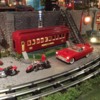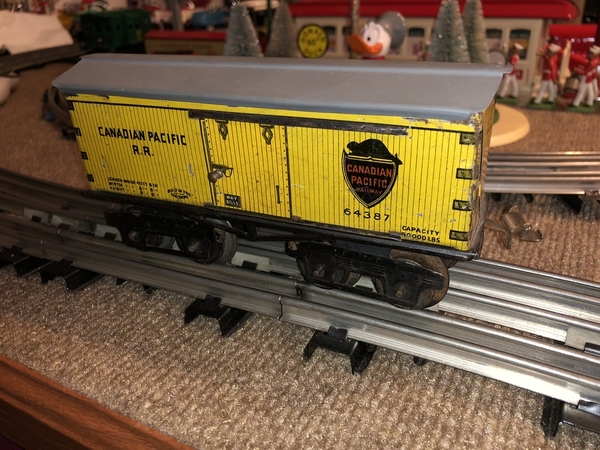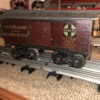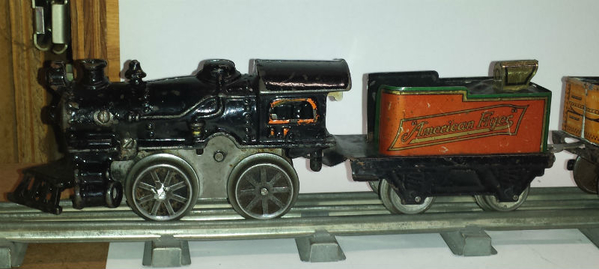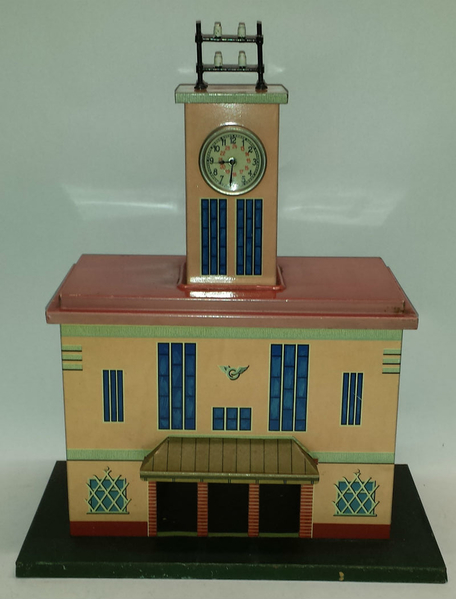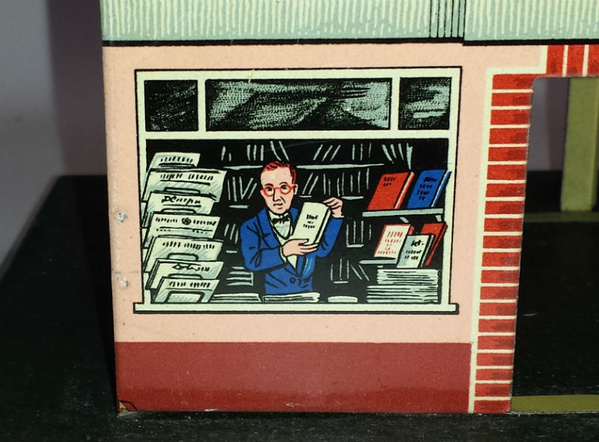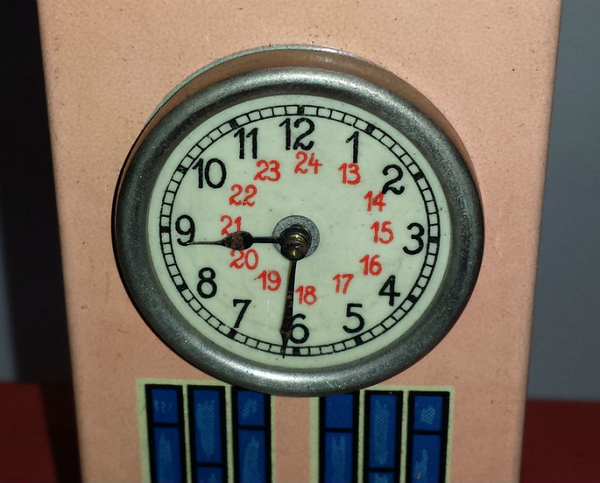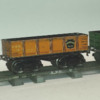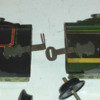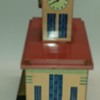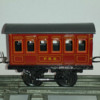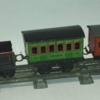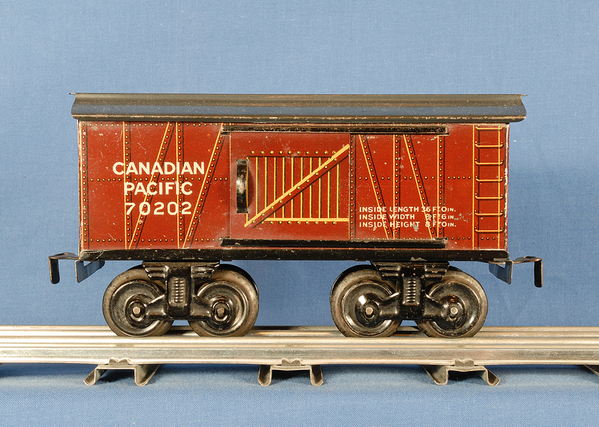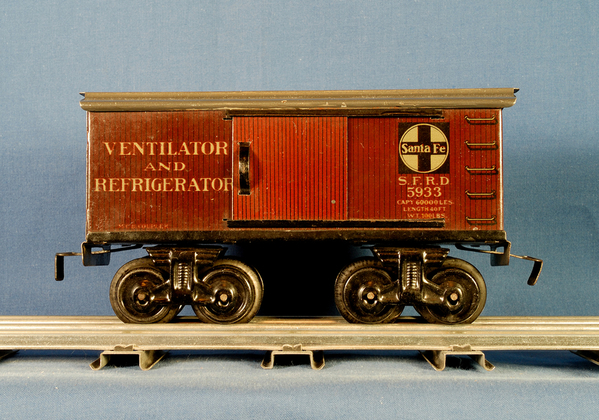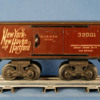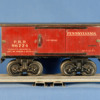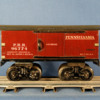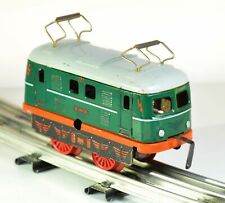Let’s see your tinplate! 🚂
Replies sorted oldest to newest
In the twenties and thirties JEP has made a great number of small accessories to complete their trains, here are some of them.
CR has also made some very nice ones,
And an important actor of railway accessories, the level crossing, those two models are a mixed of tin for the base and wood for the buildings, first one is with a traditional house and the second is more modern in style, the guards are moved by an electro magnet they both date from the fifties and were sold by BLZ and GMP, two small french makers of quality trains.
Have a nice tinplate weekend, Daniel
Attachments
An add and a upgrade.
Bing didn’t make a lot of road names in the 8 wheel Litho boxcars, so this is a nice add.
I already had a Ives CP, but this one is a bit nicer and it came from the estate of my late friend John Parker.
Attachments
Well it must be the weekend for trackside accessories as I also just bought a Hornby No.3 Platform and Station ![]()
Still in the UK but headed my way soon !



Looks a little like a caboose, but this is an original Marklin Gauge 1 "Gepackwagen," Cat. No. 1846/1, a baggage car made 1902-09.
Attachments
A Selection of Flyer Freights
NWL
Nation Wide Lines posted:A Selection of Flyer Freights
NWL
A "selection"... Wow those are in amazing shape NWL! That red 3110 just pops! and the 9" cars...just wow.
Again a few news in the collection.
American Flyer, cars found in the UK and the loco in Austria.
Brimtoy cars from the 30s, part of the Michael Foster collection
2 of the bottom with recycled sheets.
Ernst Plank station from the 30s
Fandor very small PRR coach
Greetings
Arne
Attachments
While Bing only offered 10 boxcar railroad heralds to Ives's 26 it is interesting to note the differences in the approach to prototypical railroad names between the two companies. Ives's emphasis was on herald variety with little regard for prototypical accuracy of the overall litho treatment. Bing, on the other hand, was a tinplate rivet counters dream. ![]() All of their car lithography (boxcars, gondolas, cabooses, tank cars, and hopper cars) was copied directly from the 1902 AC&F catalog - right down to the reporting marks. In addition, the 10 Bing boxcar heralds were offered in a number of different, but prototypical, basic litho colors. The boxcars can be found in bright red, boxcar red, tuscan red, dark brown, and a light brown that is almost tan in color. Since this seems to be shaping up as a line side structure/freight car Friday, below is a rogues gallery of the Bing boxcar offerings.
All of their car lithography (boxcars, gondolas, cabooses, tank cars, and hopper cars) was copied directly from the 1902 AC&F catalog - right down to the reporting marks. In addition, the 10 Bing boxcar heralds were offered in a number of different, but prototypical, basic litho colors. The boxcars can be found in bright red, boxcar red, tuscan red, dark brown, and a light brown that is almost tan in color. Since this seems to be shaping up as a line side structure/freight car Friday, below is a rogues gallery of the Bing boxcar offerings.
B&O - note the "European" style roof - it also came with an "American" style roof - as did all of the Bing boxcars
Canadian Pacific - lithographed as woodsided
Canadian Pacific - lithographed as steel outside braced - note "American" style roof
CNJ
Erie - lithographed as outside braced wooden boxcar
Illinois Central
NYNH&H
PRR - red with "European" roof
PRR Tuscan with "American" roof
Philadelphia and Reading
Santa Fe
Attachments
Rob English posted:Nation Wide Lines posted:A Selection of Flyer Freights
NWL
A "selection"... Wow those are in amazing shape NWL! That red 3110 just pops! and the 9" cars...just wow.
Rob, you don't recall seeing them when you visited? They were on the were on the wall, except for the NYC gondola, which I was finally able to upgrade. It took me years to acquire them in this condition. Here are better shots of each.
The above tank is the common version. The tank below is more uncommon, as it is on a 1928 frame, with 1928 trucks, 1928 couplers, the frame is punched for steps, and the tank is punched for number plates and ladders.
NWL
The Dorfan portion of the collection is growing.
Have a Great Tinplate Weekend
Northwoods Flyer
Greg
Nation Wide Lines posted:Rob English posted:Nation Wide Lines posted:A Selection of Flyer Freights
NWL
A "selection"... Wow those are in amazing shape NWL! That red 3110 just pops! and the 9" cars...just wow.
Rob, you don't recall seeing them when you visited? They were on the were on the wall, except for the NYC gondola, which I was finally able to upgrade. It took me years to acquire them in this condition. Here are better shots of each.
The above tank is the common version. The tank below is more uncommon, as it is on a 1928 frame, with 1928 trucks, 1928 couplers, the frame is punched for steps, and the tank is punched for number plates and ladders.
NWL
That's some brilliant stuff, there. I've never seen 9-inch lithographed cars before. Presume these are quite early?
pd posted:That's some brilliant stuff, there. I've never seen 9-inch lithographed cars before. Presume these are quite early?
They date to 1925-1927. It is reported that various gondolas and box cars were made in differing years, due to the catalogs showing different cars in different years, but who can say at this point.
NWL
My favorites so far are JKE's superb Marklin Gepackwagen, ARNE's exquisite Ernst Plank station, and RSB's NICE Bing cars!
Nation Wide Lines posted:pd posted:That's some brilliant stuff, there. I've never seen 9-inch lithographed cars before. Presume these are quite early?
They date to 1925-1927. It is reported that various gondolas and box cars were made in differing years, due to the catalogs showing different cars in different years, but who can say at this point.
NWL
I like the ghost litho inside the yellow 3007. What is the number on the lumber car?
JIM O'C: That is an interesting little, dare I say, "critter"!
Jim O'C posted:Nation Wide Lines posted:pd posted:That's some brilliant stuff, there. I've never seen 9-inch lithographed cars before. Presume these are quite early?
They date to 1925-1927. It is reported that various gondolas and box cars were made in differing years, due to the catalogs showing different cars in different years, but who can say at this point.
NWL
I like the ghost litho inside the yellow 3007. What is the number on the lumber car?
The ghost litho is pretty cool on that car. It is only on the one side, which shows in the photo, and is a reverse negative of the litho on the outside of the car. Not sure how it was created. The other side of the inside of that car was either black originally or painted black.
The number of the log car is 3006 and yes, that would be the same number as the 6 inch log car. Not sure why Flyer did that, but they had the same numbers on the 6 inch log cars as the 9 inch litho log cars.
NWL
ARNE, where is NRW ?
eddie g posted:ARNE, where is NRW ?
Eddy,
it´s in the middle of Germany, bigger towns are Dortmund and Cologne.
Greetings
Arne
Hi Fellow Tinplaters,
I picked up my first clockwork locomotive this week. As far as I know (really very little so far about clockwork) it is a Hornby No. 101, made from 1949 to 1954...although the box it came with says Hornby No. 51.
It runs a bit sluggishly if anyone can give me some clues if I need to clean it (I see some dust in the cab)? Lew/LEWRAIL was nice to suggest putting some oil on the axles, but I did not get around to that yet. Also, help with which lever does what would be appreciated.
Tom ,,,,,,,,,,,,,,,,,,,,,,,,,,,,,,,,,,,,,,,,,,,,,,,,,,,,,,,,,,,,,,,,,,,,,,,,,,,,,,,,,,,,,,,,,,,,,,
Attachments
looks great Tom
Thanks Dave.
Tom
Lionel 274W and 296 Outfits lining up for revenue service (with a Lionel No. 10 nosing in).
Enjoy the weekend!
Bob
Attachments
MNCW posted:Hi Fellow Tinplaters,
I picked up my first clockwork locomotive this week. As far as I know (really very little so far about clockwork) it is a Hornby No. 101, made from 1949 to 1954...although the box it came with says Hornby No. 51.
It runs a bit sluggishly if anyone can give me some clues if I need to clean it (I see some dust in the cab)? Lew/LEWRAIL was nice to suggest putting some oil on the axles, but I did not get around to that yet. Also, help with which lever does what would be appreciated.
Tom ,,,,,,,,,,,,,,,,,,,,,,,,,,,,,,,,,,,,,,,,,,,,,,,,,,,,,,,,,,,,,,,,,,,,,,,,,,,,,,,,,,,,,,,,,,,,,,
Tom
First is to clean any old oils and greases from the motor/axles etc. Then using a very light oil, add a drop to the axles and ends of all rotating shafts. Also a drop or two on each gear. DO NOT get any oil on the inner parts of the governor. At the und if it’s still a bit sluggish I also sometimes add a bit of oil the a few spots on the spring. That will help it unload easier.
Steve
Thanks Steve.
Tom
Nice pickup on the Hornby there ![]()
As Steve suggests Tom![]() @PRR8976
@PRR8976
Regarding the levers one is forward and reverse and the other is the brake ... pretty easy to figure out which is which lol
In your video there was clearly a scrapy squeally noise as it unloaded so check for anything that might be binding or perhaps a slightly bent axle ... It also might be corrosion between the spring plate and the motor sides , or in the governer ... a light oil everywhere except the governer and some running should start to loosen things up from no doubt years of sitting still ![]()
lubricate , run, clean and repeat ![]()
That Hornby was a NICE find! ![]()
I also grabbed a couple of wagons/tenders last night , just ... cos ![]()
A marx Nickel Plate tender

Another Hornby Cement wagon ( you can never have too many lol )

And one I will need a hand on identifying .. as usual its still in the UK so I dont have it at hand yet, but I grabbed this one cos it was only a few Pounds , and it took my fancy ... I have seen plenty of Hudson & Pacific tin tenders , but all of them have been dual bogies 4-4-'s ... this one looks to be a cheap 2-2 arrangement?...
It piqued my interest ... probably uber common to you guys, but wondering if any of my 'Murican mates can fill me in on where it comes from ?
(Showing my lack of knowledge with all things American lol )

Fatman posted:
And one I will need a hand on identifying .. as usual its still in the UK so I dont have it at hand yet, but I grabbed this one cos it was only a few Pounds , and it took my fancy ... I have seen plenty of Hudson & Pacific tin tenders , but all of them have been dual bogies 4-4-'s ... this one looks to be a cheap 2-2 arrangement?...
It piqued my interest ... probably uber common to you guys, but wondering if any of my 'Murican mates can fill me in on where it comes from ?
(Showing my lack of knowledge with all things American lol )
It is Sakai, but it looks to have been transplanted on a Marx frame. A better picture would help.
Steve
I kinda thought Sakai myself but again they had duals ... Better pics will have to wait til it gets here from the UK sadly , will be a week at least , I have one box coming but not sure if it made it in there , if not might be a month or two ![]() ( the ONE downside of having a bloke who will amalgamate and ship for you lol )
( the ONE downside of having a bloke who will amalgamate and ship for you lol )
That is some evil genius work right there if it IS mated to a Marx , but would again indicate I have an eye for the unusual , even if its worthless unusual ![]()
Some motion for your weekend
Attachments
MNCW posted:Also, help with which lever does what would be appreciated.
Tom ,,,,,,,,,,,,,,,,,,,,,,,,,,,,,,,,,,,,,,,,,,,,,,,,,,,,,,,,,,,,,,,,,,,,,,,,,,,,,,,,,,,,,,,,,,,,,,
In general the lever at the side of the hole for the key is the start/stop lever, while the lever at the other side is forward/backward; this lever should always be pushed or pulled as far as possible, without brute force of course, to engage the mechanism.
Regards
Fred





